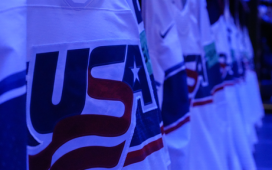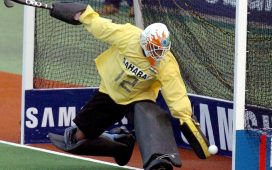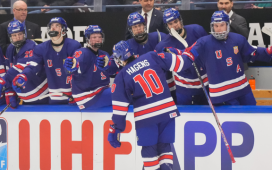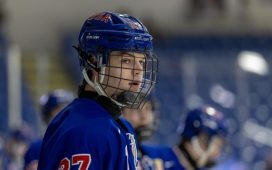The more you spend time covering this league – and it’s now 30 years-plus for this writer – the more you realize that it makes things up as it goes along. And that its rulebook is really only used as a suggestion. That was once again the case when the league’s 31 GMs got together to discuss the state of the game Tuesday at their annual November meeting.
Three nights ago in Vancouver, Matt Calvert of the Colorado Avalanche was involved in a horrific scene, one in which he took an Elias Pettersson shot directly to the face from close range with less than three minutes remaining in the game and the Vancouver Canucks in clear possession of the puck in the offensive zone. To be clear, it was a pivotal point in the game. The Canucks were trailing by two goals and had their goaltender pulled for an extra attacker. Even after Petterson motioned to the officials that Calvert was badly hurt, referees Justin St-Pierre and Garrett Rank and linesmen Kiel Murchison and Shandor Alphonso allowed play to continue. The Canucks retained possession while Calvert lay on the ice, scoring 14 seconds after Calvert was injured.
Under Rule 8 that deals with injuries, the NHL rulebook states that, “If the player’s team is in control of the puck at the time of the injury, play shall be stopped immediately unless his team is in a scoring position.” But then it goes on to say, “In the case where it is obvious that a player has sustained a serious injury, the Referee and/or Linesman may stop the play immediately.” (Italics mine.)
So when the GMs met in Toronto, they had an opportunity to tighten up that rule, you know, to maybe prevent something like this from ever happening again. But they didn’t. And the reason for that is because it’s a league where the GMs down to the coaches and the players only give lip service to player safety. The league is still concerned that if it makes blowing the play dead mandatory, it will encourage coaches to have players fake injuries to take advantage of the rule and have play stopped.
Nice, eh? How difficult would it have been for the league to say that officials must stop play if they believe a player has been seriously injured?
“We’re always concerned about the competitive aspect of games,” said senior executive vice-president of hockey operations Colin Campbell. “Look no further than why a goalie can’t have a warm-up. Coaches are competitive and they took the rule and they used it as a time out and they just put the goalie back in again. We’re always worried about how competitively they’ll take rules and use them.”
NHL director of officiating Stephen Walkom acknowledged that one of the officials on the ice should have blown the play dead. “It seemed like an eternity in that game, even though it was closer to four or five seconds,” he said. (It was actually 14. Petterson’s shot hit Calvert with 2:51 remaining and the Canucks scored with 2:37 remaining.) “The puck was moving around, the players were checking, the player attempted to get up and, of course we would have like to have blown the play down earlier, especially when it resulted in a injury.”
Walkom said the league officials are directed to kill the play when they see a serious injury, especially to the head or the face. “That was at a spot in the middle of the ice that I don’t think anyone had a great sightline on,” Walkom said. “They just wanted to make sure. And by the time they were sure, the puck was in the net.”
Hey, this is not an easy call. The league is very conscious about diving and embellishing, as it should be. But at some point the players and coaches in this league, who claim to live by this nebulous code of honor that nobody can clearly define, need to take ownership over this. Because of that attitude, a player lay bleeding on the ice with a serious injury for 14 seconds Saturday night. The league deals with this stuff on an almost daily basis and it’s never an easy call because the players and coaches don’t make it an easy call. Campbell brought up the case of former NHLer Erik Cole, saying Cole had a reputation with the league office for embellishing hits and injuries along the board.
“We thought he embellished a lot,” Campbell said. “Then he went into the boards one time and (we thought), ‘Here we go again,’ and he broke his neck. You’ve got to be careful, but you also have to understand players are competitive, the game is competitive and teams and people do what they can to win. We told the managers that we’re going to have to live with judgment on the part of the officials.”
Another example of things being open in a big way to interpretation resulted from the spitting incident Monday night when Garnet Hathaway of the Washington Capitals hocked a loogie at Anaheim Ducks defenseman Erik Gudbranson after getting punched in the head during a scrum. Hathaway received a match penalty and will have a disciplinary hearing Wednesday as a result, even though there’s really nothing in the rulebook to support it.
Rule 23.8, which deals with infractions that could result in a game misconduct (not a match penalty, and there is a clear difference) include, “spitting on or at an opponent or a spectator.” But prior to that it says – again in a most confusing way – that “the following list of infractions can also result in a game misconduct being assessed.” (Italics mine.) This is a very important distinction because match penalties are viewed as much more serious than game misconducts and a player receiving a match penalty is suspended indefinitely until the league rules on the issue. But the referees – in this case Wes McCauley and Peter MacDougall – thought the act was so egregious that it deserved a match penalty.
So if Hathaway receives anything more than a fine – and even if he receives just that – expect the NHL Players’ Association to raise bloody heck. Because in this case, it seems the league isn’t even governing itself by its own rulebook. I asked Campbell yesterday what the difference is between a player spitting at an opponent and licking his face, something Brad Marchand has done twice without any repercussions. Marchand was, however, put on notice by the league and told any further behavior like that would be subject to further discipline. Campbell declined comment.
So if I have this straight, the NHL wants to make sure it does the right thing when it comes to a player getting spit upon. It certainly doesn’t want a repeat of that. And, hey, that’s noble. You just wish it would be as adamant and unwavering when it comes to a player getting a puck in the face.
Want more in-depth features, analysis and an All-Access pass to the latest content? Subscribe to The Hockey News magazine.








